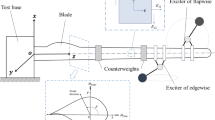Abstract
Full-scale fatigue test is an effective method for validating the fatigue performance of wind turbine blade. Its primary problem is how to design the test load. The conventional approach to determine test load requires a complicated and time-consuming process. Thus, a simplified method for directly converting load spectrum of blade into test load is proposed in this paper. Firstly, beam theory is used to obtain the relationship between stress, strain and bending moment of blade cross section. Based on the assumption of local stress concentration and linear relationship between stress and strain, M-N curves (applied moment vs. allowable number of cycles to failure) is defined. Secondly, based on Miner's linear cumulative damage theory and constant life diagram, the equivalent fatigue cumulative damage of load spectrum which is equal to the damage of full-scale fatigue test is obtained. Then, in the case of the selected test load ratio and cycles, the mean and amplitude of test load can be solved. Finally, the validity of the proposed method is verified by an illustrative example. The result indicates that the error of the calculated results between this method and the traditional method is close to 5 %, and it can be used for fatigue test and improve the efficiency of test load design.
Similar content being viewed by others
References
Caithness Windfarm Information Forum, Summary of wind turbine accident data to 31 March 2017, Available at: http://www.caithnesswindfarms.co.uk.
International Electrotechnical Commission, IEC 61400–1 Wind turbines part 1: Design requirements (2005).
International Electrotechnical Commission, IEC 61400–23 Wind turbines Part 23: Full–scale structural testing of rotor blades (2014).
X. Guo, X. Fu, H. Shang and J. Chen, Integrated aerostructural optimization design of pre–bend wind turbine blades, Journal of Mechanical Science and Technology, 30 (11) (2016) 5103–5113.
P. Malhotra, R. W. Hyers, J. F. Manwell and J. G. McGowan, A review and design study of blade testing systems for utility–scale wind turbines, Renewable and Sustainable Energy Reviews, 16 (2012) 284–292.
H. F. Zhou, H. Y. Dou, L. Z. Qin, Y. Chen, Y. Q. Ni and J. M. Ko, A review of full–scale structural testing of wind turbine blades, Renewable and Sustainable Energy Reviews, 33 (2014) 177–187.
P. Brøndsted and R. P. Nijssen, Advances in wind turbine blade design and materials, Woodhead Publishing, Cambridge, UK (2013).
G. Freebury and W. Musial, Determining equivalent damage loading for full–scale wind turbine blade fatigue tests, Proceedings of the 19th American Society of Mechanical Engineers (ASME) Wind Energy Symposium, Reno, Nevada, USA (2000) 50.
S. Larwood and W. Musial, Comprehensive testing of Nedwind 12–Meter wind turbine blades at NREL, Proceedings of the 19th American Society of Mechanical Engineers (ASME) Wind Energy Symposium, Reno, Nevada, USA (2000) 51.
R. P. L. Nijssen, Fatigue life prediction and strength degradation of wind turbine rotor blade composites, Contractor Report SAND2006–7810P, Sandia National Laboratories, Albuquerque, New Mexico, USA (2006).
Y. H. Huh, J. H. Lee, D. J. Kim and Y. S. Lee, Effect of stress ratio on fatigue life of GFRP composites for WT blade, Journal of Mechanical Science and Technology, 26 (7) (2012) 2117–2120.
P. R. Greaves, Fatigue analysis and testing of wind turbine blades, Doctoral Dissertation, Durham University (2013).
J. C. Dai, W. Hu and X. B. Shen, Load and dynamic characteristic analysis of wind turbine flexible blades, Journal of Mechanical Science and Technology, 31 (4) (2017) 1569–1580.
O. A. Bauchau and J. I. Craig, Structural analysis: With applications to aerospace structures. Springer, New York, USA (2009).
Germanischer Lloyd, Guideline for the certification of wind turbines (2010).
S. Larwood, W. Musial, G. Freebury and A. G. Beattie, NedWind 25 blade testing at NREL for the European standards measurement and testing program, National Renewable Energy Lab., Golden, Colorado, USA (2001).
Author information
Authors and Affiliations
Corresponding author
Additional information
This paper was presented at ICMR 2017 & QR2MSE 2017, Crowne Plaza Chengdu West, Chengdu, China, October 24–27, 2017. Recommended by Guest Editor Dong Ho Bae.
Qiang Ma is currently a Ph.D. candidate in School of Mechanical and Electronical Engineering at Lanzhou University of Technology of China. His research interests include fatigue life prediction and fatigue testing of wind turbine blade.
Zong-Wen An is a Professor of School of Mechanical and Electronical Engineering at Lanzhou University of Technology of China. He received the Ph.D. degree in mechanical engineering from University of Electronic Science and Technology of China in 2009. He is a senior member of Chinese mechanical engineering society. His research interests include structural reliability analysis, mechanical design theory and methodology.
Rights and permissions
About this article
Cite this article
Ma, Q., An, ZW., Gao, JX. et al. A method of determining test load for full-scale wind turbine blade fatigue tests. J Mech Sci Technol 32, 5097–5104 (2018). https://doi.org/10.1007/s12206-018-1006-y
Received:
Revised:
Accepted:
Published:
Issue Date:
DOI: https://doi.org/10.1007/s12206-018-1006-y




